Frank Sidebottom and the man behind the mask
- Published
Compare the real Frank in 1994 with the new film character
Cult comic character Frank Sidebottom has inspired a film starring Michael Fassbender, while a documentary and biography are also in the works. Four years after his creator Chris Sievey died, why is Frank's legend growing and who was the man behind the mask?
The giant home-made head. The ridiculously nasal Mancunian voice. The anarchic and absurd humour. The deliberately naff pop songs.
That was Frank Sidebottom.
He was an unmistakable and irrepressible creation who found a following in the 1980s and '90s on late-night student telly and Saturday morning children's shows, as well as on the comedy circuit.
He was a strange mixture of eccentric comedy creation, surreal performance artist and cartoon character come to life. While he attracted a devoted following, he was destined to remain a cult concern.
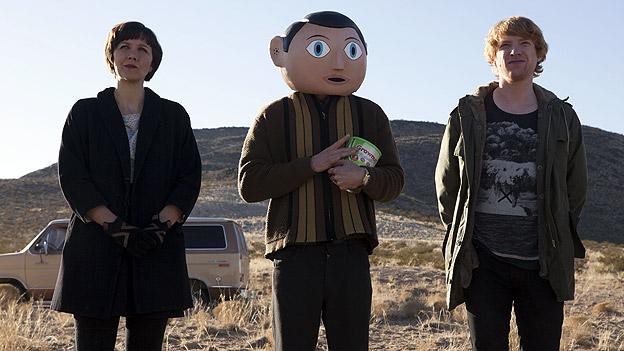
The Frank feature film stars Maggie Gyllenhaal, Michael Fassbender (centre) and Domhnall Gleeson
So it is stranger still that he should have inspired a film featuring Hollywood stars Michael Fassbender and Maggie Gyllenhaal, which gets its UK premiere at the Sundance London film festival on Friday.
The film, titled Frank, was co-written by journalist and broadcaster Jon Ronson, who spent three years playing keyboards in Sidebottom's Oh Blimey Big Band in the late 1980s.
In his movie, Fassbender plays a musician called Frank who wears an oversized comic-book head.
That, however, is where the similarities with the original Frank Sidebottom end. In the film, the title character is a misunderstood musical genius as opposed to a purveyor of Bontempi-swing novelty pop songs.
The Frank of the film hails from Bluff, Kansas, rather than Sidebottom's native Timperley, Greater Manchester. He also has a disconcertingly deep voice.
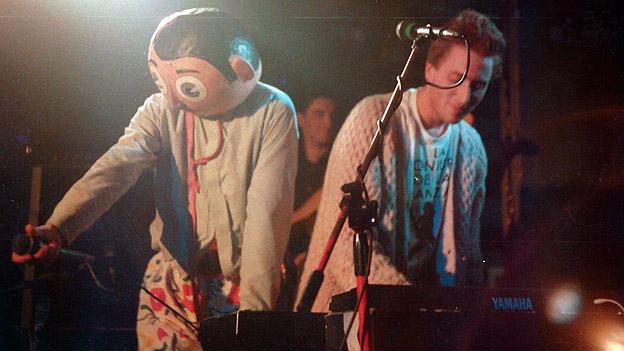
Jon Ronson has also written a book drawing on his time in Frank Sidebottom's Oh Blimey Big Band
Ronson changed the character because he did not want to make a straightforward biopic of Sidebottom and his creator. Chris Sievey, who was consulted before his death in 2010, did not want that either.
Sievey guarded his true identity and was worried that, in a straight biopic, "the reality of Chris would somehow undermine the mystery of Frank", Ronson says. So the writer kept the name and the head but fictionalised the rest.
However, Sievey's real story is arguably more interesting than the version that is about to hit the big screen.
Before Frank Sidebottom was born, Sievey was desperate to make it as a musician.
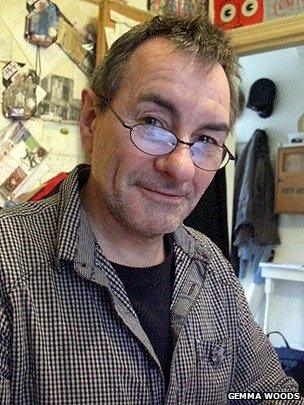
Chris Sievey, pictured in 2007, was the man inside Frank Sidebottom's giant head
Aged 15, he hitch-hiked from Manchester to the Apple Records headquarters in London with his brother and staged a sit-in before engineers eventually let them record a session.
With his post-punk band The Freshies, Sievey was on the fringe of the late-1970s Manchester scene.
"He was just a really nice, amiable chap," remembers Mick Middles, who wrote for music magazine Sounds and is now writing a biography titled Out Of His Head.
"All the other Manchester musicians were very competitive and he didn't seem to be. He was just nice to be around."
Sievey wrote countless letters to record companies and got countless rejection letters in return. Undeterred, he set up his own label.
But the closest they got to the charts was number 54 in 1981. After The Freshies split, Sievey kept making music while also experimenting with the newfangled art of computer programming.
In 1983, he released the solo single Camouflage. On the B-side was the audio data for "the world's first computer promo", a music video, external created entirely using the Sinclair's blocky graphics.
But his music career was going nowhere. Sievey was an all-round, restless creative spirit and in the early 1980s Frank Sidebottom started to take shape.
"I think he tried every which way to be successful, and for whatever reason it just wasn't happening," says David Arnold, Sievey's road manager for the last five years of his life.
"I think he got to a point where he thought, 'Shove it. I'm just going to do something that entertains me.' Fortunately he came up with the Frank thing and people liked it."
Arnold is now working with director Steve Sullivan on a documentary about Sievey titled Being Frank, external.
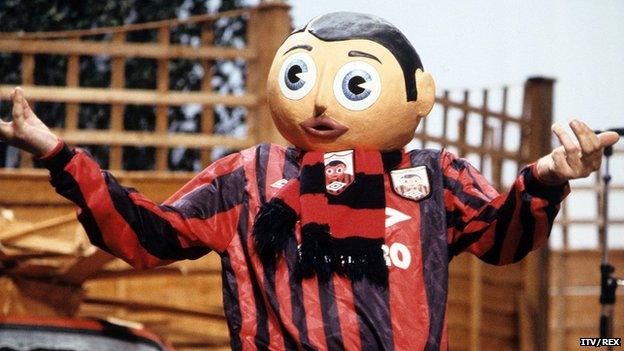
Frank Sidebottom's Fantastic Shed Show ran on ITV in 1992
Frank took off, appearing on Piccadilly Radio in Manchester, children's TV programme No 73, Anthony H Wilson's Channel 4 game show Remote Control and slots on BBC Radios 2 and 5.
He supported boy band Bros at Wembley Stadium in 1989 (disastrously by all accounts) and reached the peak of his fame with his own TV series, Frank Sidebottom's Fantastic Shed Show, on ITV in 1992.
Sievey was deadly serious about staying in character as Frank Sidebottom when he was wearing the fake head.
"If he had the head on and you called him Chris, he would just ignore you," says Arnold. "I think he went above and beyond the call of duty with that.
"Everything would change - his body language, the way he sat, the way he moved, the way he talked. You were with another person.
"It didn't matter whether there was just one person there or five people or 500 people. When the head was on, you were in Frank's company. Chris was gone."
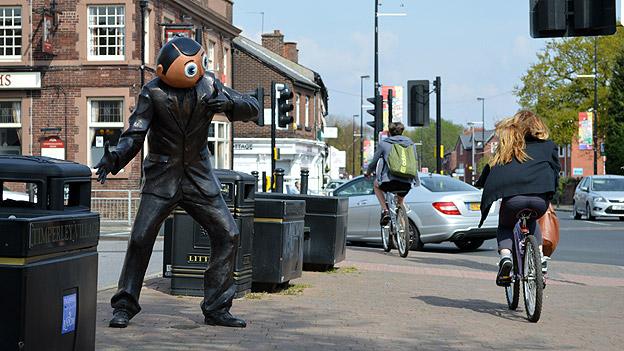
A statue of Frank Sidebottom has been erected in the character's beloved Timperley, Greater Manchester
When his drawings, models and animations went on exhibition at Chelsea College of Art and Design in London in 2007, Sidebottom turned up to the opening.
"He splashed paint all over the walls at this opening," Middles says. "The people running it ran up to Chris afterwards and said, 'Why the hell did you do that?'
"He said, 'What are you asking me for? It was Frank.' That was how he lived his life.
"He used to write letters from Chris to Frank. He had two sets of handwriting. And he'd post them. Things like that he'd do all the time."
So to what extent was Frank Sidebottom just an act, a part Chris was playing? Or did it become an alter ego, a completely different persona?
"You've got to be careful not to psychoanalyse him too much because it might be wrong," Jon Ronson cautions.
"But my feeling is that if Chris was incredibly chaotic and Frank was incredibly innocent, there's got to be a reason for that, right?
"And to encase yourself in this fake head… there has to be a reason. It was safer. Frank was a calmer, safer place to be than Chris."
David Arnold describes Chris and Frank as two separate identities. He says: "I think they were two different people with some interests that crossed over - namely The Beatles and Thunderbirds.
"In some ways they were polar opposites, in that Frank was very childlike, very innocent. Chris was very the much rock'n'roll lifestyle, let's say."
Sievey's "rock'n'roll" exploits were a world away from Sidebottom's innocent life.
Mick Middles describes how Sievey "did the whole drink and drugs thing as much as any rock star you could think of".
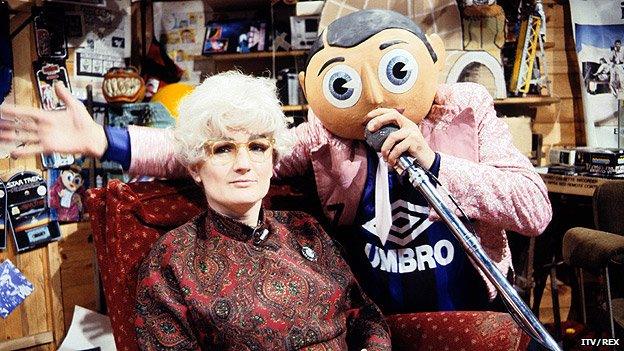
Caroline Aherne began her career as Frank Sidebottom's neighbour Mrs Merton
While Frank Sidebottom was enjoying his mid-1990s heyday, a remarkable cast of Sidebottom sidekicks began to overshadow him in the limelight.
Sievey had asked his brother-in-law's friend Caroline Aherne to voice the part of Frank's neighbour Mrs Merton for a radio show. Mrs Merton went on to get her own TV show before Aherne achieved comic greatness with The Royle Family.
Chris Evans, who was a driver for Chris/Frank, became a household name as a DJ and TV host. Ronson found success as a writer and presenter, while Mark Radcliffe - another band member - is now a BBC Radio 2 and 6 Music host.
"He did become a little bit embittered, naturally, I think," Middles suggests.
Sievey was too undisciplined to build on his success, Ronson believes. "Because he was quite chaotic he didn't see things through to the end," he says.
'Couldn't get rid of him'
"Somebody like Caroline Aherne was really focused. She would work at Mrs Merton or The Royle Family until it was brilliant.
"Chris was more chaotic and scatterbrained and was just a twig in the tidal wave of whatever was happening that day. I think that was ultimately to the detriment of his art."
Sievey put Sidebottom into retirement after his fortunes dwindled in the late 1990s and began working as an animator on children's shows like Pingu and Bob the Builder.
But the giant head came back off the shelf in 2005. "He couldn't get rid of him," Mick Middles says. "I think Chris resented Frank because Frank just kept coming back.
"Chris wanted to do other things. He wanted to make films and do lots of other stuff but eventually he had to go back to Frank because Frank was the only way of making a decent living.
"The story's quite sad towards the end, not just with his illness but because he was drinking and doing everything heavily."
Sievey died of cancer in June 2010. He left behind three children and an ex-wife.
Novelty act or genius?
Reckless with money, Sievey was virtually penniless when he died. When word got around that he was to have a pauper's funeral, Sidebottom's army of fans mobilised to raise £15,000 in 24 hours.
Their devotion continued with campaigns to raise a slightly surreal statue of Sidebottom in leafy Timperley and to fund the Being Frank documentary.
Today, fans and friends insist Sidebottom was more than just a novelty entertainer.
Steve Sullivan says he sees Sievey and his creation as "a performance artist, or as a work of art", while Mick Middles describes him as an outsider artist.
After Sievey died, Mark Radcliffe said he was "one of the very few people I met whom I would call a genius".
Jon Ronson agrees. "It's certainly how I saw him back when I was plucked from obscurity to join a band," he says. "I thought I was in the presence of genius."
Frank screens at the Sundance London film festival on 25 and 27 April and will be released in the UK on 9 May. Being Frank and Out Of His Head are due out later this year. Jon Ronson's book Frank: The True Story That Inspired The Movie is out now.
- Published20 October 2013
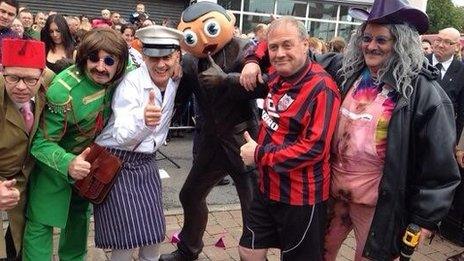
- Published31 May 2013
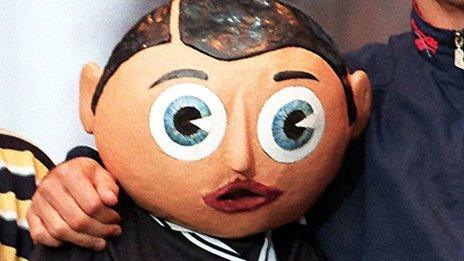
- Published7 September 2012
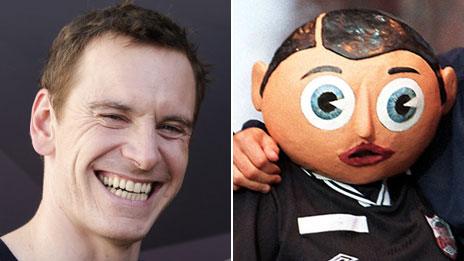
- Published1 November 2010
- Published21 June 2010